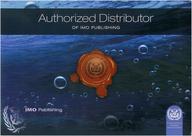Catálogo - LIBROS NÁUTICOS - Derroteros, Guías de Navegación y Guías de Turismo
Mediterranean Cruising Handbook
Autor: Rod Heikell
Editorial: Imray
Año de edición: 2.012
9781846231704
Encuadernación: rústica
280 pág.
19,0 x 24,5 cm.
38,50€
Contenido:
For anyone heading down to the Mediterranean this book has all the essential information for planning a voyage, covering topics that range from weather and climate, equipping the yacht for cruising the Mediterranean, navigation, anchoring, radio, communications and the internet, to marine life and food. There is a seven-language glossary of boating terms as well as sections on routes to the Mediterranean and history. This long awaited sixth edition has been expanded and includes new sections on marine reserves and the environment as well ass the very latest information on technical matters. The country-by-country sections has been brought up to date, and new colour photographs by Lu Heikell and amended plans give the pages a fresh look.
The Handbook now includes a list of useful routeing waypoints for the entire Mediterranean wich are shown on overprinted charts folded into the back of the book.
It is the ideal companion to the author's biennial Mediterranean Almanac and his pilots for the area.
Índice:
1. THE MEDITERRANEAN
1.1. Vital statistics
1.2. Component seas
1.3. Component countries
1.4. Geology
1.5. Hydrology
1.6. Climate
1.7. Pollution
1.8. Flora
2. HISTORY AND CULTURE
2.1. Historical perspectives
2.2. Archaeological and historical sites
2.3. Food
2.4. Wine
2.5. A short history of yachting in the Mediterranean
2.6. Guidebooks
3. YACHTSMAN'S SEVEN-LANGUAGE DICTIONARY
3.1. Directions
3.2. Navigation
3.3. Chart terms
3.4. Light characteristics
3.5. In harbour
3.6. Ship's papers
3.7. Weather terms
3.8. Boat types
3.9. Sails and rigs
3.10. Parts of a boat
3.11. Boat equipment
3.12. Boat engine
3.13. Tools
3.14. Metals
3.15. Materials
3.16. Timber
3.17. Fastenings
3.18. First aid
3.19. Ashore
3.20. Colours
3.21. Numbers
3.22. Arabic numerals
4. YACHT AND EQUIPMENT
4.1. Equipment
4.2. Diesel engines
4.3. Gas
4.4. Electrics
4.5. Sail care
4.6. Rope sizes and strengths
4.7. Knots
4.8. Conversions
4.9. Wind lay-up checklist
5. ANCHORING AND BERTHING
5.1. Anchors
5.2. Anchor chain/rope recommendations
5.3. Anchoring problems
5.4. Anchoring techniques
5.5. Fouled anchors
5.6. Berthing Meaditerranean-style
5.7. Stern or bows-to
5.8. Fouled anchors (berthing)
5.9. Marina berths
6. MARINE LIFE
6.1. Marina life
6.2. Sand, rocks, mud and sea
6.3. Dangerous marine animals
6.4. Aide-memoire for yachtsmen to avoid polluting the sea
6.5. Marine reserves
6.6. Common Mediterranean marine life
7. BASIC FIRST AID
7.1. First aid box
7.2. Shock
7.3. Heart pain
7.4. Choking
7.5. Fainting
7.6. Epilepsy
7.7. Stroke
7.8. Unconsciousness
7.9. Wounds and bleeding
7.10. Abdominal injuries
7.12. Head injuries
7.13. Stove-in chest
7.14. Climatic illness (heat injuries)
7.15. Fractures
7.16. Spinal injuries
7.17. Burns and scalds
7.18. Diabetic emergencies
7.19. Weil's Disease (leptospirosis)
7.20. Common poisons
7.21. Seasickness
7.22. Bee and wasp stings
7.23. Jellyfish and other marine stings
7.24. Snakebites
7.25. Sprains and strains
8. SAFETY AND NAVIGATION SCHEMES
8.1. SOLAS regulations
8.2. GMDSS
8.3. Distress signals
8.4. Life-saving signals
8.5. Signal flags
8.6. IALA buoyage System A (including International Port Traffic Signals)
8.7. Traffic regulations
8.8. Traffic Separation Schemes
8.9. Lights, shapes and sound signals
9. NAVIGATION
9.1. Chart data
9.2. Chart information
9.3. Paper charts
9.4. Electronic charts
9.5. Chart sources on the web
9.6. GPS accuracy
9.7. Multi-function displays and networking
9.8. Route planning
9.9. Waypoints
9.10. Radar
9.11. AIS
9.12. Racons
9.13. The Magnetic Compass
9.14. Course to Steer
9.15. Position-fixing
10. COMMUNICATIONS
10.1. Landline telephones
10.2. Mobile phone and data communications
10.3. Local SIM card voice & data communications
10.4. Wireless internet access
10.5. Internet cafés
10.6. Voice over Internet Protocol (VolP)
10.7. Satellite phone & data communications
10.8. Data communications using HF radio
11. RADIO SERVICES
11.1. Common terms and abbreviations
11.2. Licences
11.3. Marine bands
11.4. Coast radio
11.5. Radiotelephony rules
11.6. Normal radiotelephony procedure
11.7. GMDSS distress procedure
11.8. Ship-to-shore telephone calls
11.9. Prowords
11.10. The standard phonetic alphabet
11.11. Morse Code
12. WEATHER AND WEATHER SERVICES
12.1. About weather data
12.2. Global warming
12.3. Prevailing summer winds
12.4. Coastal effects
12.5. Gales
12.6. Named Mediterranean winds
12.7. The Beaufort Scale
12.8. Weather fronts
12.9. Synoptic chart
12.10. Weather by radio
12.11. Navtex
12.12. SafetyNET
12.13. Weather on the internet
12.14. Weather for the bandwidth impaired
12.15. GRIB Files
13. ROUTES TO THE MEDITERRANEAN
13.1. Northern Europe
13.2. The Danube
13.3. From across the Atlantic
13.4. From the Red Sea
14. THE MEDITERRANEAN COUNTRIES
14.1. National and religious holidays
14.2. Gibraltar
14.3. Spain
14.4. France % Corsica
14.5. Monaco
14.6. Italy
14.7. Malta
14.8. Slovenia
14.9. Croatia
14.10. Republic of Bosnia-Herzegovina
14.11. Montenegro
14.12. Republic of Albania
14.13. Greece
14.14. Turkey
14.15. Cyprus
14.16. Syrian Arab Republic
14.17. Lebanon
14.18. Israel
14.19. Egypt
14.20. Libya
14.21. Tunisia
14.22. Algeria
14.23. Morocco
15. MEDITERRANEAN ROUTES & WAYPOINTS
15.1. Waypoint selection
15.2. Route planning
15.3. Plotting waypoints
15.4. Using waypoints
15.5. Routeing considerations
15.6. Waypoint derivation
15.7. Waypoint accuracy
15.8. Major landfall waypoints
15.9. Mediterranean Routes
15.10. Distance Tables
16. USEFUL BOOKS
INDEX
Precio: 38,50 €, I.V.A. incluido (4%)
[ Volver ]


